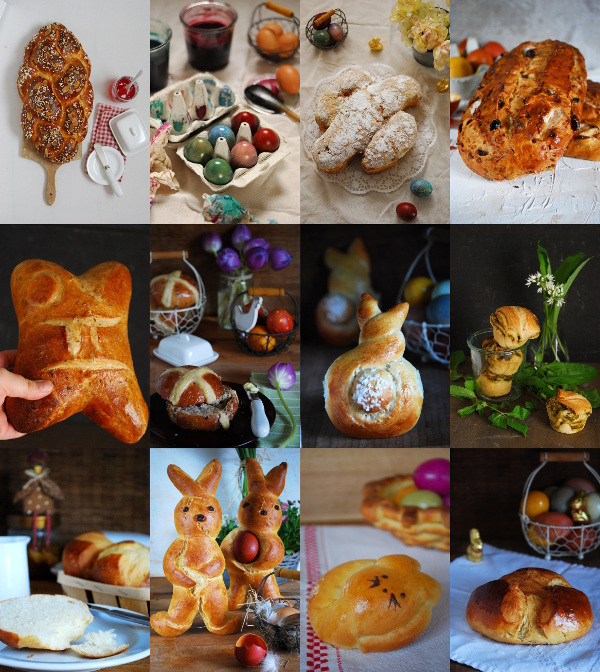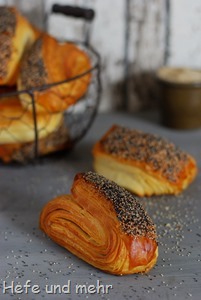 Today I’m quite happy that the first of may is a holiday because this gives me the time to bake something for the Bread baking day in the last second. Susanna asked us to bake Bread around the world and so I travled north in my mind and baked Tebirkes. Tebirkes are a danish poppy seed roll made with a kind of puff pastry. They are not only made with dark poppy seeds but can be topped with white poppy seeds as well. In my cupboard I found a forgotten bag with white poppy seeds I bought in the indian supermarket some time ago and so I well equipped for making Tebirkes. Continue reading
Today I’m quite happy that the first of may is a holiday because this gives me the time to bake something for the Bread baking day in the last second. Susanna asked us to bake Bread around the world and so I travled north in my mind and baked Tebirkes. Tebirkes are a danish poppy seed roll made with a kind of puff pastry. They are not only made with dark poppy seeds but can be topped with white poppy seeds as well. In my cupboard I found a forgotten bag with white poppy seeds I bought in the indian supermarket some time ago and so I well equipped for making Tebirkes. Continue reading
Bread Baking for Beginners X: Spelt Rye Bread
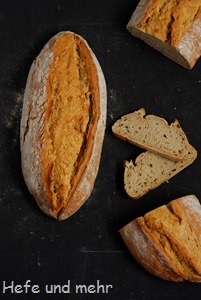 So here is now the promised Spelt bread. I know that many of the readers of this blog like to bake with spelt, but baking with spelt flour is a little bit more challenging then baking with wheat flour, so the recipe comes relatively late in my bread baking course.
So here is now the promised Spelt bread. I know that many of the readers of this blog like to bake with spelt, but baking with spelt flour is a little bit more challenging then baking with wheat flour, so the recipe comes relatively late in my bread baking course.
Spelt is closely realted to wheat. But there are two thing to keep in mind when working with spelt. Flour made from spelt contains a different composition of gluten proteins which finally results in a more fragile gluten network. This makes it easy to “over knead” spelt dough, meaning that the dough is kneaded longer then it takes to obtain full gluten development which ends in breaking down the gluten network once again. Due to this fact I prefer to knead spelt dough by hand which gives me a better control then kneading with the kitchen machine. If kneading with the machine it is important to keep a close eye on the dough and testing the gluten development by the window pane test. Intervall kneading (kneading shortly with breaks in between) can be handy as well. Continue reading
Bread baking for Beginners IX: Salzstangerl

I asked at the last Bread baking course post if you have special breads you would like to bake. And Uschi then asked for recipe for “Salzstangerl”. These are long rolls sprinkled with salt and caraway seeds and they can be found mainly in Austria. And as I planed to bake the next bread in our course with Pâte Fermentée as preferment these rolls fitted very well in my plans for the weekend.
The Pâte Fermentée contains flour, yeast, salt and water. It can be either a part of a bread dough which is kept in the fridge (that’s why some people call it “Old dough”) or it can be mixed and fermented as a normal prefermt (what I do most of the time). It adds a part of full develope gluten network to the dough which helps to improves the gluten structure. The flavour notes are complex, a little bit nutty and only slightly sour.
Bienenstich Muffin
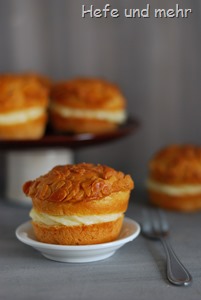 “Bienenstich” is a traditional german cake and its name literally means “bee sting”. For me it is a classical cake to serve on Sundays together with some coffee. When my parents visited us last sunday, I decided to make some muffin sized little Bienstich. Their dough is a “sibling” of my actual favourite braid, but in contrast to the original recipe it contains more cream and no butter. For a relaxed baking I let them proof overnight in a muffinpan in the fridge. And due to the fact that my kitchen machine kneads much better when using 500g flour, I doubled the amount of dough and made a little braid for breakfast with the second half.
“Bienenstich” is a traditional german cake and its name literally means “bee sting”. For me it is a classical cake to serve on Sundays together with some coffee. When my parents visited us last sunday, I decided to make some muffin sized little Bienstich. Their dough is a “sibling” of my actual favourite braid, but in contrast to the original recipe it contains more cream and no butter. For a relaxed baking I let them proof overnight in a muffinpan in the fridge. And due to the fact that my kitchen machine kneads much better when using 500g flour, I doubled the amount of dough and made a little braid for breakfast with the second half.
The only little disadvantage is the height of the muffin which makes it challenging to eat it. The easiest way is to split it in two halves. Then it is very easy to enjoy this delicious cake!
Bitter Orange Curd
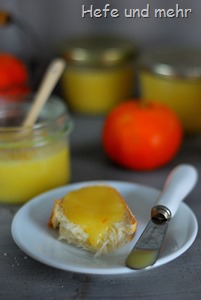 Two Kilogram of bitter oranges found their way into my kitchen last week. Not for making marmelade – there I prefer the sweet variant – but for making candid orange peel! But for making candid orange peel I needed to juice all of them. And I was suprised about the great flavour of the juice, combined with a clear tartness. And there was no trace of bitter flavour.
Two Kilogram of bitter oranges found their way into my kitchen last week. Not for making marmelade – there I prefer the sweet variant – but for making candid orange peel! But for making candid orange peel I needed to juice all of them. And I was suprised about the great flavour of the juice, combined with a clear tartness. And there was no trace of bitter flavour.
But what should I do with the delicious juice? A bitter orange curd, of course! I did a big batch as I had enough juice which had to be used. Two of the glasses I gave to dear friends – the rest I kept for myself. Together with my favourite braid this makes a perfect breakfast on sunday!
Bread Baking for Beginners VIII: Wild Spring Herbs Bread
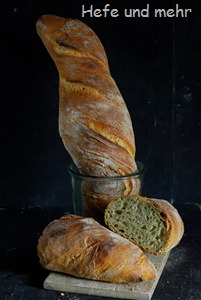 In the last days, the weather was warm and sunny and it finally feels like real spring. The first trees started to flower and the leaves will develop soon and the world will be green once again. And already the first fresh herbs can be found in garden and forest, like wild garlic, ground elder and salad burnet. Blended together this herbs yields an aromatic paste which adds a great flavour to this crusty bread and turns the crumb slightly green.
In the last days, the weather was warm and sunny and it finally feels like real spring. The first trees started to flower and the leaves will develop soon and the world will be green once again. And already the first fresh herbs can be found in garden and forest, like wild garlic, ground elder and salad burnet. Blended together this herbs yields an aromatic paste which adds a great flavour to this crusty bread and turns the crumb slightly green.
As preferment I used a poolish. A poolish is made with the same amount of water and flour and a tiny little bit of yeast. It rise for 14-16 hours and has to used while its surface is still doomed. In contrast to a biga, which is really forgiving when used half a day later then planned, a poolish has only a limited time window in which it can be used. After that it starts to degrade and collapse. But it helps the dough to rise well and adds a mild, complex flavour. The name poolish comes from the polish bakers who brought this kind of dough to France in former times. Here he is used often for baguette dough.
Raspberry Torte with Cream Cheese Core

My little Sister likes Raspberry Torte very much and so I like to bake one or the other Variation for her. This year I orientated myself on the Raspberry Charlotte I made last year. To the raspberry mousse I added a cream cheese core and a raspberry-red currant disc. The fruits are frozen ones because April is definite to early for summer fruits. The basis of the cake is a flourless chocolate sponge I found at Kochpotein Evas Blog. The only optical minus point is the fact that I own only one small cake ring and so I filled the incredients for the disc in a shallow bowl. So it is missing straight sides but I can live with it. The cake is light and fruit, just like we like it.
Happy Birthday, dearest Sister!
Schiacciata di Pasqua
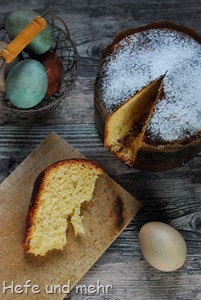 Sometimes you stumble over a recipe and then it catches you so much, that you change all your plans just to bake it. For me this happend when I read about the Schiacciata di Pasqua, the Tuscan Easter bread similar to Panettone. It is baked with olive oil, what tempted me very much. And because I was feeding my sweet starter anyway to bake a Colomba pasquale I decided to make to festive breads for Eastern in parallel.
Sometimes you stumble over a recipe and then it catches you so much, that you change all your plans just to bake it. For me this happend when I read about the Schiacciata di Pasqua, the Tuscan Easter bread similar to Panettone. It is baked with olive oil, what tempted me very much. And because I was feeding my sweet starter anyway to bake a Colomba pasquale I decided to make to festive breads for Eastern in parallel.
For my recipe I checked many formula available in the net but had to realize that the amount of olive oil varies a lot. At the end I placed my recipe somewhere in the middle. A little change to the original formula is that I avoided to add anise seeds which I do not like at all. But I added them in the recipe in brackets, because the traditional Schiacciata di pasqua has to contain these seeds.
It is a very delicious bread in the end, sweet with a subtle hint of olive oil and very slight sourness from the sourdough. The crumb can be teared into long fibers and is very light. A perfect gift for the family on Easter Morning!
Bread Baking for Beginners VII: Soy yoghurt roll
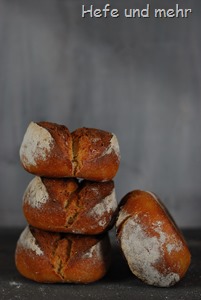
Today we jump back once again to simple recipes without preferment because I got some mails asking if the sourcream or yoghurt can be replaced somehow to make the recipe free of lactose or vegan. The obvious idea was to replace the yoghurt with soy yoghurt and that was what I was suggesting. But I don’t like to advice something I did not tested and so I bought some soy yoghurt. And just repeating a recipe is borrowing and so I started to create a new recipe. It contains a bit of rye flour which adds a hearty note to its flavour, the soy yoghurt give subtle sourness to the rolls. The crust is crisp, the crumb soft. And I can say that exchanging yoghurt with soy yoghurt works perfectly well!

